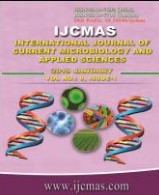


 National Academy of Agricultural Sciences (NAAS)
National Academy of Agricultural Sciences (NAAS)

|
PRINT ISSN : 2319-7692
Online ISSN : 2319-7706 Issues : 12 per year Publisher : Excellent Publishers Email : editorijcmas@gmail.com / submit@ijcmas.com Editor-in-chief: Dr.M.Prakash Index Copernicus ICV 2018: 95.39 NAAS RATING 2020: 5.38 |
Aerobic rice (Oryza sativa L.) is widely grown in eastern India. Soil moisture stress and unscientific ways of sowing, limit its yield and grain quality. Thus, a field experiment was conducted at Central Rainfed Upland Rice Research Station, Hazaribagh, Jharkhand, India during rainy season of 2016, to study the effects of irrigation regimes, soil adjuvants and planting methods on growth, and uptake and portioning of micro-nutrients in aerobic rice. The experiment was laid-out in a split-plot design replicated thrice. The treatments included 4-irrigation schedules, irrigation at 0.9, 1.2, 1.5 IW/CPE ratio and no-irrigation (rainfed), and 2-soil adjuvants (soil adjuvant applied and no-soil adjuvant) allotted to main-plots and 2-planting methods–conventional dry seeding at 20 cm row spacing and spot-sowing (dibbling of 4-seeds/hill at 20 × 15 cm interval) to the sub-plots. Irrigation at IW/CPE 1.5 exhibited the highest tiller count which was 4.2, 10.6 and 18.7% higher than IW/CPE, 1.2, IW/CPE 0.9 and rainfed treatment. The conversion of tillers to effective tillers was higher in IW/CPE 1.5 and 1.2 than water stressed crop (IW/CPE 0.9 and rainfed). Irrigation at IW/CPE ratio 0.9, 1.2 and 1.5 caused 16, 25 and 40% enhancement in filled-grain weight panicle-1, respectively, over rainfed crop; the corresponding reduction in grain sterility was 21, 33 and 47%. Total uptake of Fe, Zn, Cu and Mn went up by 23.3, 24.6, 24.4 and 24.4%, respectively, in IW/CPE 1.5 over rainfed condition. Micro-nutrient harvest index and partial factor productivity of applied N, P and K also stood highest in IW/CPE 1.5. Spot-planting resulted in significantly larger tiller-count, higher number of panicles m-2 with larger and heavier panicles compared to conventional planting. Micro-nutrient accumulation and harvest index were also higher with spot-planting. Soil adjuvant application did not express significant effect on any of the studied parameters. Hence for better crop growth and accumulation of micro-nutrients and their larger portioning towards grains, aerobic rice should be spot-planted and irrigated at IW/CPE 1.5 under adequate water supply and at IW/CPE 1.2 when water is limited.
 |
 |
 |
 |
 |